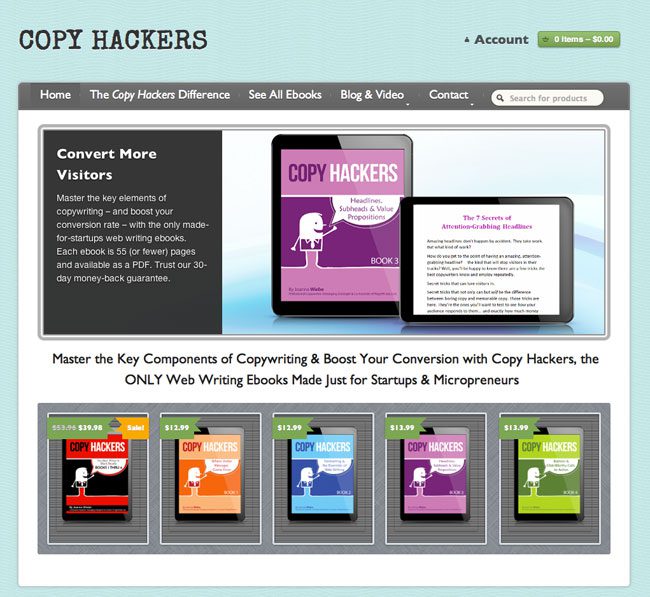
A case study by Lance Jones on building an e-commerce store selling digital downloads using Coquette and WooCommerce.
Joanna, my amazing wife, is an equally amazing Web copywriter, who recently left her senior position at Intuit (makers of QuickBooks and TurboTax) to build her own online business. Over the past year and in her spare time she has been helping Web startups and entrepreneurs improve their conversion rates by writing more effective copy.
Humble beginnings
It all began with a humble request for help by a start-up co-founder, and ended up on the front page of Hacker News (kind of a Digg for developers and start-ups), resulting in a massive wave of emails flooding Joanna’s inbox with additional pleas for copy and conversion advice.

Knowing she couldn’t possibly help everyone who responded, Joanna asked what I thought about the idea of tailoring a series of copywriting e-books to start-ups and selling them online. It made complete sense to me. But should we sell the e-books on Amazon? Build our own site from scratch? The latter sounded pretty daunting, even with my experience putting sites together (you could call me a developer lite), as you have to deal with payments, refunds, PCI compliance, content management, etc.
Six months later, Joanna had completed the initial versions of her three e-books, each about 150 pages in length. Copy Hackers was born. Initially we thought we’d go with Amazon as our primary sales channel, but several advance copy readers had trouble with the length of the e-books. They felt too big to the developers we were going to be selling to. And so Joanna decided to break them up into 50-page PDFs, each one delving into a very specific area of Web copy such as creating amazing headlines, stellar product messages, and get-your-attention-and-click-right-now buttons.
With this shift to bite-sized PDFs, which would eventually result in a series of 8 (or more) e-books. We decided to market them ourselves instead of on Amazon, using our own Web site, www.copyhackers.com.

Building the Copy Hackers site
With domain name in hand and the [shorter version] e-books 1 through 4 completed, I considered our options for a Web site. Having a site designed and built from scratch would be time-consuming, expensive, and a pain to continually edit. Alternatively, we’d tried our hand at premium WordPress themes before, and loved how you can produce a very professional-looking design while at the same time get a fullyfunctioning content management system.
I took the plunge and spent $35 at ThemeForest, but after having installed the theme and several plug-ins, I learned that it did not support digital products (i.e., downloadable items such as e-books). Live and learn. Then I purchased a second theme from ThemeForest (this time, one that supported downloads!), but its e-commerce features were somewhat lacking. No real biggie, as the theme also supported third party e-commerce plug-ins.
I turned to reading reviews of several WordPress e-commerce plug-ins, and learned about the newly-released WooCommerce plug in. Since I’d already spent $70 on themes, the free and highly-rated WooCommerce plug-in was a great, but I was disappointed to learn that in order to make everything work together visually, I would need to modify the ThemeForest theme extensively.
But instead of trying out more e-commerce plug-ins for my existing theme, I decided to stick with WooCommerce, and went in search of a third and final theme thinking that perhaps I should look at WordPress themes from the developer of WooCommerce. WooCommerce offered everything we needed, and it seemed extremely likely that using it in conjunction with a WooThemes theme would meet our ever-expanding list of requirements. We were not disappointed and went with Coquette.
Out of the box, everything worked as it should. Installation was a snap. Configuration took no time. And getting it all working with PayPal Standard was surprisingly easy (love the PayPal Sandbox feature!). Even setting up the theme to work with MailChimp was far less efort than I had anticipated.
From there, we wanted to make a few adjustments for our online business. I [eventually] took WooThemes advice and modified the various templates using the Custom CSS option rather than modifying the core CSS files. I learned it the hard way, however, after upgrading the WooCommerce plug-in and watching a bunch of tweaks disappear from our site. Live and learn again.

We also needed to modify many of the form field labels and page headings, and I quickly discovered that WooCommerce and Coquette come with the ability to create custom language files. Modifying pretty much anything on a page template is simply a matter of find & replace via the theme’s localization control panel.
In all, we spent about a week’s worth of time setting up the Copy Hackers site. And on October 18th, Joanna submitted a blog post about her start-up journey to Hacker News.
Site performance and sales
Within one hour of submission to the site, her post received enough up-votes to hit the home page (where there are 30 other tech-related stories). And soon thereafter, her post rose to #2 on the home page, staying there for several hours and funneling a ton of trafc to the Copy Hackers site. By the end of the second day (when her post eventually disappeared from the home page), Joanna’s site received more than 10,000 unique visitors. And better yet, by using the same tips she outlines in her e-books, Joanna persuaded more than 500 visitors from around the world to purchase her top priced product (and best deal), the 4-book bundle. For us, it was a mind-blowing launch, and our WooTheme didn’t buckle once under the pressure.
What’s next for us? Analyzing the recent sales and trafc data. More blog posts. PPC landing pages. An experiment with afliates. More e-books. And perhaps a go with PayPal Express — when it’s available in WooCommerce.
Thanks a million for creating something so amazing, guys! You’ve given us the ability to focus on our business instead of the technology that powers it.

